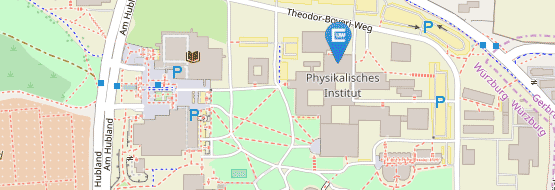A04
Growth of HgTe topological insulators, Weyl and Dirac semimetals
Summary
Within the SFB 1170 the project A04 provides high quality, MBE-grown HgTe epitaxial layers for the investigation of topological properties. The recently developed strain-engineering technology and the newly established optical temperature control enables us to make use of the large variety of different topological states provided by HgTe, such as 2D and 3D topological insulators (TIs), non-magnetic or magentically doped [1], as well as Dirac, Weyl and Kane semimetals. The availability of high quality sample material is one of the most important issues for a successful research project. Project A04 has long years of experience on the epitaxial growth of the topological insulator material HgTe. Continuous improvements have been achieved which provide us now with HgTe structures exhibiting carrier mobilites of over 1 × 106 cm2 /Vs. The referred elastic mean free path exceeds 10 μm. These high quality structures are favorable for all kind of investigations on undisturbed surface states, especially transport experiments of these states became accessible for device sizes which are no longer restricted to the sub-micrometer range. Starting from an already Figure 1: Longitudinal and Hall resistance of a 2D (left) and a 3D HgTe TI structure. high sample quality in this project we will explore new ideas and concepts for further enhancements and developments towards novel topological phenomena. An important development is the improved quality of HgTe layers grown on doped GaAs sub- strates. The two primary advantages are (i) the intrinsic back gate and (ii) the low cost-large area wafer material. During the last funding period, it was possible to grow quantum well structures with a mobility over 1 × 105 cm2/Vs, where gating into the quantum spin Hall regime could be achieved by either top or back gate. Since back gating is useful for all type of experiments, and especially for sur- face probe techniques or optical investigations, the optimization of the II-VI on III-V growth conditions is therefore an important point during the next funding period. Here, the main focus will be set on the surface roughness. Currently, HgTe layers grown on GaAs substrates exhibit a comparably high surface roughness which is problematic for all local probe measurements or micrometer size devices. We will also explore different additional commercially available substrate materials suitable for MBE growth. The primary candidates are InAs and InSb. These materials provide a lattice constant much closer to HgTe and thus we expect that a smoother transition reduces the number of lattice defects and hence improves the crystalline quality and surface morphology. Continuing the pioneering work on the MBE-growth of HgTe during the coming funding period we will explore the growth on substrates with different, crystalline surface orientations, other than (001). Recent theoretical consideration predict that the changed surface symmetry will give rise to non-zero surface Berry curvatures which allow for further topological effects, absent in materials grown on (001) surfaces, and for certain lattice orientations a strong piezo-electric effect is expected which would for example allow for topological switching between trivial and topological states.


